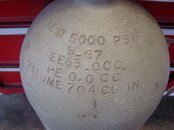Thank you. This is exactly the information that I was looking for, but I do have a few follow up questions. Suppose a tank has been overfilled to the point of plastic expansion enough to produce a volume of, say, 50cc more than it's baseline capacity. The tank then goes in for hydro which adds, say, another 5cc (but still passes) and it's service is continued.
As far as I can tell, there is no baseline established for a particular cylinder's volume, and the hydrotest will measure only the initial, loaded, and rebound volumes of a particular tank. In theory, an overfilled LP tank could see any number of plastic expansions before it's deformation is measured, and even then it's an isolated measurement. In this case, the tank that left the hydro facility with 55cc of expansion from it's born date might return next round with 100cc of expansion, and nobody would know it.
Obviously very few keep records like you have, but I am curious...how much expansion is too much when looking at the life of a cylinder? It would seem to me that, for a cylinder operating continuously at close to or above yield strength, a simple hydrostatic test may be limited in it's usefulness. Is this a valid point to consider?
I am sorry I didn't make it clear that the elastic expansion is the portion of the expansion that returns back to zero, it is purely elastic (the approximately 55 cc is elastic).
The magnitude of the plastic expansion has to stay less than or equal to 10% of the elastic to pass hydro. The hydro is only checking if the material is still ductile (elastic).
To answer your question is yes there would be a very small increase in volume every time the cylinder is pressurized into it yield stress, but look at the relative numbers.
We are talking about a 5 cc increase (of max permanent expansion, or it fails) for a cylinder that has a total volume of 11,960 cc. That is a permanent volume increase of 0.04%. You will never notice.
The hydro test does not care about any permanent expansion from the previous hydro test. All it is measuring is if the material at this instant is still elastic enough or has it become somewhat brittle.
The issue with filling to 4000 psi or higher (into the lower end of the yield stress) is that you are work hardening the material.
It is similar to bending a metal coat hanger. Sure you can bend it a number of times and it can still be used to temporarily hold your car muffler, but if you bend it once too many it fractures because it has become very brittle in the spot that it has been work hardened (by bending).
The coat hanger example is obviously a lot more extreme since the level of deformation, but anyone that has done it knows that it doesn't take that many cycles.
A scuba cylinder that is taken to the lower level of the yield stress will be able to tolerate a lot more cycles, but enough of those cycles and it will shorten its life. The amount that it will shorten its life is probably not an issue if it is cough during a regular hydro test. The material will show as being more brittle.
Most of my steel 72 are 40 years old (some are older) and I expect that they will last me for a very long time.
I hope that answers your question.
Wow, I am a slow typist and it takes me a long time to write all this stuff.
Last edited:




